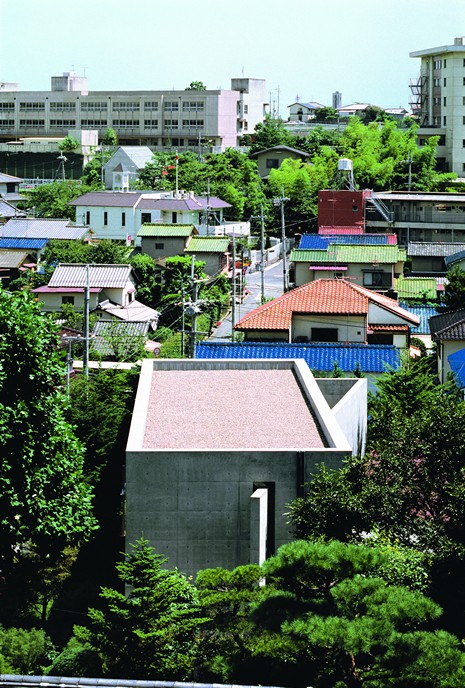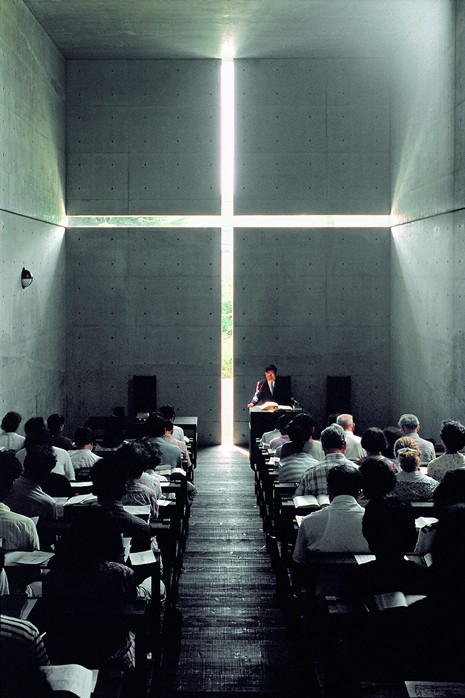Description
The building is situated in a quiet but built-up suburban neighbourhood. It consists of an angular wall and a rectangular box, both made of concrete constructed in situ. The angle is formed by two free standing planes placed at an angle of 75 degrees to one another. The longer of the two legs is aligned north-south, piercing the rectangular volume of the church on its westward side before exiting through the end wall to the north. Where the wall and box meet, open or glazed slots preserve the autonomy of both elements.
On arrival, one turns right and enters the “vestibule”, already within the main volume of the building. Produced by the collision between the angular wall and the box, this forecourt tapers in a narrow wedge shape. One continues on through a large 1.65 by 5.35 metre opening, a gap in the angular wall as it passes through the building and turns right again to look from the back towards the front of the main “nave”.
The dimensions of the box, 18 by 6.28 by 6.28 metres, are the equivalent of three cubes arranged behind one another. The pitch-black cedar wood floor descends in shallow tiers towards the ambo. The pews, made of rough planking, divide down the middle to leave an aisle through the centre. The rear wall behind the ambo is divided once vertically and once horizontally, leaving two thin strips of light, which together form a slot in the sign of the cross. In the mornings until midday rays of sunlight stream through the opening, illuminating a cross on the floor that shifts as the day progresses. The only other natural illumination is provided by the full-height glazed opening on the west wall.
The interior of the chapel is quite dark, acquiring a green or blue tinge from the daylight reflecting off the smooth concrete. According to the architect, this was the only way to transform light into a sign of belief. The building draws on the language of Le Corbusier and Louis Kahn on the one hand, and Richard Serra and Carl Andre on the other. Its sparse, reserved character has caused critics to celebrate it as an “architecture of silence.” Together with Peter Zumthor’s Sogn Benedetg Chapel in Somvix, Switzerland, it has had a profound influence on sacred architecture since 1990.
Some ten years after its construction, the Chapel of the Light was extended to provide a Sunday school to the west of the chapel. Its form repeats the same basic formal principle with a similar angular wall and box. Today, the shape and spatial arrangement of both singularly ascetic buildings form a pair inseparable from one another.
Althaus, Birgit: Kirchen. Die schönsten Gotteshäuser des Christentums, Erftstadt 2007, p. 123 | Tadao Ando, Zurich and Munich 1990, pp. 120- | Tadao Ando. Album de l’Exposition, exhibition catalogue, Paris 1993, p. 25 | Tadao Ando. Light and Water, Basel 2003, pp. 64 | Architecture Intérieure Créé, no. 253/1993, pp. 66-, p. 69 | AIT Architektur, Innenarchitektur, Technischer Ausbau, no. 5/1993, pp. 28- | Architettura e spazio sacro nella modernità, exhibition catalogue, Milan 1992, pp. 224 | AV Monografías, NR. 95/2002, p. 40- | Bertoni, Franco: Minimalistische Architektur, Basel 2002, p. 106- | Botond, Bognar: Die neue japanische Architektur, Stuttgart 1991, pp. 124- | Bognar, Botond: The Japan Guide, New York 1995, p. 220 | Casabella, no. 558/1989, p. 15- | Chiesa Oggi, no. 21/1996, pp. 56- | El Croquis, no. 44/1990, pp. 98- | Detail, no. 3/1991, Konstruktionstafeln and no. 7/1999, p. 1225 | Domus, no. 712/1990, pp. 25- | Drew, Philip: Church on the Water. Church of the Light. Tadao Ando, London 1996, cover, pp. 40- | Faith and Form, no. winter/1992/1993, p. 12 | Flagge, Ingeborg (Ed.): Jahrbuch für Licht und Architektur 1993, Berlin 1994, pp. 39- | Flügge, Matthias, Meschede, Friedrich (Ed.): warum! Bilder diesseits und jenseits des Menschen, exhibition catalogue, Ostfildern-Ruit 2003, p. 279, p. 282 | Frampton, Kenneth: Tadao Ando, exhibition catalogue, New York 1991, cover, pp. 38- | Fujiki, Takao (Ed.): Religious Facilities. New Concepts in Architecture and Design, Tokyo 1997, pp. 51- | Furuyama, Masao: Tadao Ando, Basel 1995, p. 140- | Furuyama, Masao: Ando. Die Geometrie des menschlichen Raums, Cologne 2006, cover, p. 4, pp. 36- | Futagawa, Yukio: Light and Space. Modern Architecture 1, Tokyo 1994, p. 201 | Futagawa, Yukio (Ed.): Tadao Ando. Details, Tokyo 1991, pp. 156- | Glancey, Jonathan: 20th C Architecture. The Structures that Shaped the Century, London 1998, p. 117 | GA Global Architecture Document, no. 22/1989, pp. 88- | Heathcote, Edwin, Spens, Iona: Church Builders, London 1997, pp. 134- | Heneghan, Tom: The Colours of Light. Tadao Ando Architecture. Richard Pare Photography, London 1996, pp. 66-, p. 220- | The Japan Architect, no. 6/1989, pp. 18- and no. 11/12/1989, pp. 25- and no. 1/1991, pp. 126- | Jodidio, Philip: Tadao Ando, Cologne 1997, back cover, p. 9, p. 23, p. 32, p. 38, p. 47, pp. 84- | Jodidio, Philip: Ando. Complete Works, Cologne 2004, pp. 124- | Kind-Barkauskas, Friedbert (et al.): Beton Atlas. Entwerfen mit Stahlbeton im Hochbau, Basel 2002, pp. 196- | Krafft, Anthony (Ed.): Architecture Contemporaine, Vol. 12 1990/1991, Lausanne 1990, pp. 246- | Major, Mark (et al.): Made of Light. The Art of Light and Architecture, Basel 2005, p. 68 | Matsuba, Kazukiyo: Ando Architect, Tokyo 1998, pp. 129- | Montagnana, Francesco: Birkhäuser Architekturführer. Japan. 20. Jahrhundert, Basel 1997, pp. 204- | Ottagono, no. 134/1999, pp. 38- | Pearman, Hugh: Contemporary World Architecture, London 1998, pp. 164- | Progressive Architecture, no. 2/1990, cover, pp. 88-, p. 95 | Sabatucci, Antonio (Ed.): Costantino Ruggeri. L’Architettura di Dio, Milan 2005, p. 138, p. 141 | Steele, James: Architecture Today, London 1997, pp. 116- | Techniques et Architecture, no. 405/1992, cover, pp. 73- | Thiel-Siling, Sabine (Ed.): Architektur! Das 20. Jahrhundert, Munich 1998, pp. 164- | Thorne, Martha (Ed.): The Pritzker Architecture Prize. The First Twenty Years, Chicago 1999, pp. 154
Drawings
Site plan, the chapel on the right, the Sunday school on the left
Perspective view of the “nave”
Axonometric view
Longitudinal section
Photos

Exterior view from the north

View of the rear wall with the sign of the cross
Originally published in: Rudolf Stegers, Sacred Buildings: A Design Manual, Birkhäuser, 2008.